Morning glory in landscape design: the use of a plant
A highly leafy and extremely abundantly flowering plant called morning glory, it is one of the most beautiful and spectacular garden vines. Dark green leaves create a beautiful contrast with brightly colored flowers, the colors of which can vary from pale blue to deep purple and even reddish-burgundy shades.
Content:
Common types of morning glory
This plant has a considerable number of species, but two of them are the most common in horticulture.
We are talking about such varieties as the tricolor morning glory, which has very large flowers, and the purple morning glory:
- Ipomoea tricolor (Ipomoea tricolor). It reaches a height of 2 m. The leaves are rich green, large, heart-shaped, with a wrinkled surface. Flowers in the form of a funnel up to 10 cm in diameter, collected in bunches of 3 or 4 pieces. The colors are very diverse, depending on the variety: blue, pink, blue, purple. Flowers open with the first rays of the sun and close at sunset. In cloudy weather, they remain open all day. Morning glory has a long flowering period: from July to October.
- Ipomoea purpurea (Ipomoea purpurea). The height of the stem reaches 4 m. The leaves are bright green, oval in shape, pointed at the ends and with a notch at the base. The flowers are funnel-shaped with a diameter of up to 6 cm. Ipomoea Purple has varieties with double flowers: Scarlet Giant and Serenade with large scarlet and cherry-red corrugated flowers. The flowering period is the same as that of the Tricolor Ipomoea.
- Landscape designers are increasingly using the Moonflower Ipomoea (Ipomoea alba) in their work for its unique ability to bloom at night. Stem height reaches 3 m.White flowers up to 10 cm in diameter, similar in shape to petunia, have a pleasant almond aroma. Liana blooms from mid-summer until the first frost.
Growing morning glory
Growing morning glory does not require much effort and skills. It is quite easy to care for, it grows very quickly, therefore it needs a support installed for it in a timely manner.
Morning glory loves a lot of warmth and light, so it should be planted in a sunny place and at a time when the air is steadily warming up above +12 degrees. Before planting, the soil must be well fertilized with organic matter and loosened. If several plants are planted, then planting holes are made at a distance of 30–40 cm from each other. The plants are placed in a hole and the space between the roots is carefully filled with soil. The surface is covered with 5 cm thick mulch.
Ipomoea seedlings can be grown independently. Seeds are sown in early April. To do this, they are previously placed in slightly warm water for several days so that they swell well.
Ipomoea seeds have a very hard shell, and without soaking, they may not germinate.
The first shoots appear in a week, and then grow rather slowly. Dive seedlings should be very careful not to damage the root system. Ipomoea should be planted in open ground together with a lump, then it will take root more easily.
After planting, the morning glory is fed mineral fertilizers every two weeks and until it grows.Plants are watered with water at room temperature, making sure that there is no stagnation of water.
Morning glory in landscape design
Morning glory in landscape design is widely used, first of all, when decorating any vertical surfaces (for example, lattice or mesh fences, gates, various columns, walls of gazebos and even tree trunks with a not too lush crown).
Different varieties of plants planted side by side and entwining the same surface, the flowers of which are painted in contrasting tones, look extremely beautiful. Morning glory in landscape design has also found application in the design of various kinds of horizontal surfaces. These include, first of all, a variety of flower beds and creeping living carpets.
A living fence made of morning glory looks attractive not only during flowering, but also when it fades and the leaves acquire yellow, orange and red shades. If conifers grow nearby, the effect is greatly enhanced by the unique contrast.
The arch at the entrance to the garden or the pergola above the seating area, entwined with morning glory, is a real masterpiece of garden art. And if they are covered with the Moon-flowering morning glory, then in the twilight of a summer evening, white flowers will look like lanterns illuminating the garden. In addition, their delicate scent spreads throughout the garden, infusing an evening bliss after a hot summer day.
Another interesting design solution is planting morning glories in garden vases. If you build a frame in the form of a bouquet of flowers over a vase, then the morning glory will first curl the frame, and then lower its stem down, the result will be an incredibly beautiful composition. It looks especially impressive against a green background. lawn.



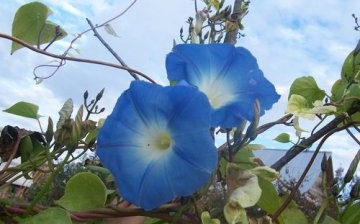

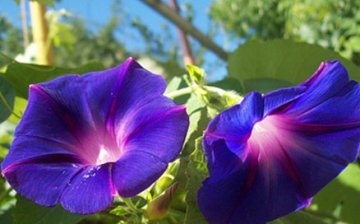

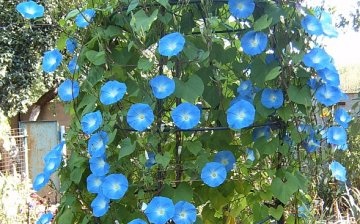





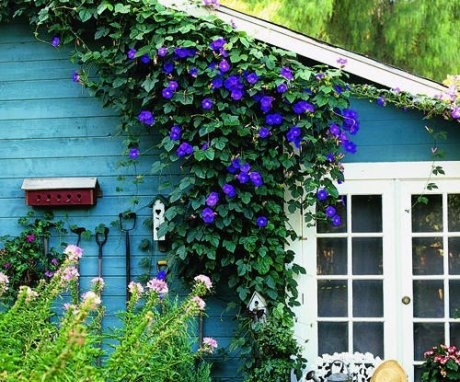
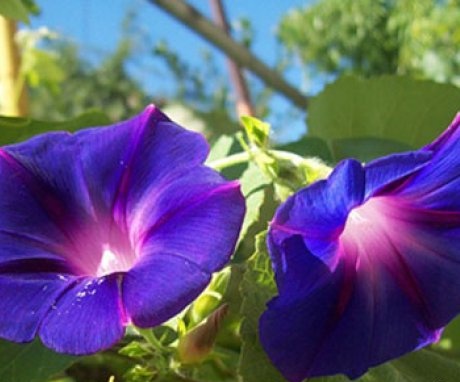
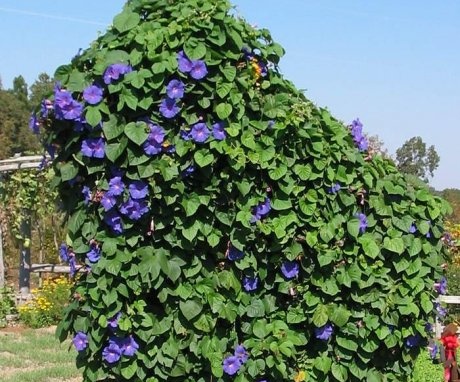
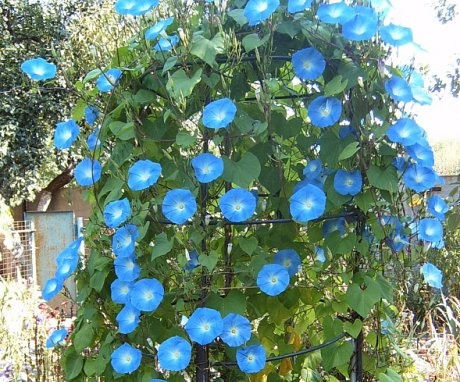
And I have been growing morning glory for 5 years on the balcony. It turns out very, very beautiful - the balcony is covered with greenery with bright eyes of flowers.